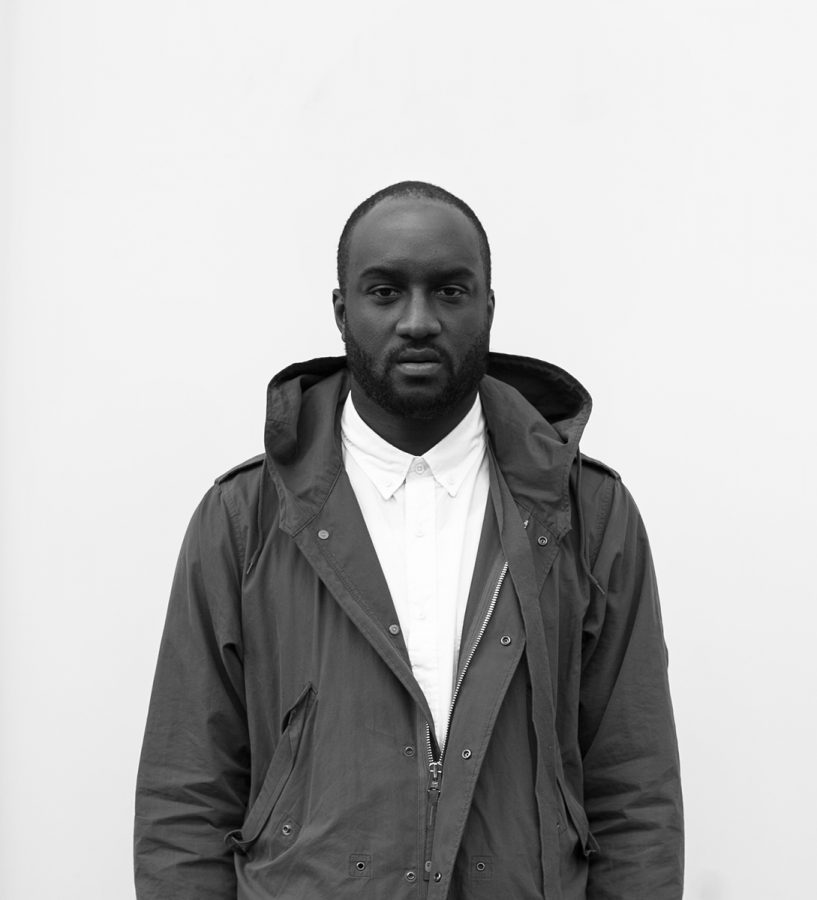‘FIGURES OF SPEECH’: VIRGIL ABLOH AND THE APPROPRIATION OF IRONY
What does it mean to exhibit a streetwear label as art? The joke may be on Abloh.
October 21, 2019
The highly anticipated art show of fashion designer and visual artist Virgil Abloh opened at the Museum of Contemporary Art (MCA) in Chicago on June 10 of this year. It was so popular (one of the MCA’s most popular shows ever) that the museum decided to extend the exhibition a week beyond its original closing date to Sept. 29. The exhibit was designed by Michael Darling, chief curator James W. Alsdorf, with curatorial assistance from Chanon Kenji Praepipatmongkol, Marjorie Susman Curatorial Fellow. Organized as a 20-year survey of Abloh’s work, the bulk featured pieces from Abloh’s most famous project, his high-end fashion label “Off-White”.
The exhibit included one of Abloh’s foremost. Originally intended as an experiment, he printed the words “PYREX 23” on Ralph Lauren flannel shirts and priced them to sell for $550 each, or “an astonishing markup of about 700%.” It was a runaway success. He is also known for t-shirts screen printed with Caravaggio’s paintings and a variety of ironic quotations.
A Ghanian immigrant, Abloh was born and raised in Rockford, Ill., and studied architecture at the Illinois Institute of Technology in Chicago. His time spent in Chicago was significant; it was influential on how he came to perceive the industrial nature of urban landscape. It’s also where he first met future collaborator Kanye West. Abloh and West were in the same internship class at the Italian fashion label Fendi before Abloh established the brand he is best known for today, the streetwear company “Off-White”, in 2012.
One of Abloh’s original design inspirations was the stylistic choices of kids skateboarding and making graffiti in the city. They were “mixing established designers with streetwear brands,” making them “owners of their own space.” Abloh intended “Off-White” to be a new type of fashion concept revolving around the idea of streetwear, what he saw as “fashion looking for a change.”
“I see the term streetwear as more of a catchphrase to define a way of making than what people might determine it, as a style of clothing. In my eyes it’s more of an art movement and less a fashion trend,” said Abloh, speaking in the exhibit’s video installation.
Abloh also discussed the contemporary language of irony and how it uses the conventions of mass media and culture.
“I come from a generation was finding this newfound freedom in being ironic…the internet sort of cracking open this sort of language that became almost impenetrable by big brand…..It’s the ability to say two things at one time,” said Abloh. “I’ve been identifying with the power of advertising, how at its essence, that it’s what drives culture, that drives taste, that drives decisions, drives everything from elections to what you have for lunch.”
However, Abloh has missed something here about the irony present in his work. As soon as we put $1,000+ price tags on these items, they’re transformed from cultural statements into tokens of cultural appropriation. Streetwear (or skateboarding, graffiti, etc.) was already its own cultural phenomenon. The Kardashians (and here I include both the Jenners and Kanye) wearing up charged streetwear on the catwalks at Paris Fashion Week is the appropriation of what were originally clever statements of irony. The tourist’s need to understand that culture is pacified by cold, hard cash.
Here, I’m neither making a moral indictment on the buying and selling of luxury clothing items nor making a value judgment that conceptual art as better or worse than any other type of art. Instead, I’m trying to distinguish Abloh’s work with “Off-White as luxury clothing merchandise rather than conceptual art. Through exhibiting designer pieces from his brand in a museum of contemporary art, we’ve removed them from their normal context, hoping to see them as a cultural and artistic phenomenon of their own. But it’s not convincing. Abloh hasn’t come up with a new concept. He’s simply taken what the “kids in the streets” were already doing, repackaged and resold it. They were the ones creating conceptual art; copying their ideas in order to make money on the other hand is counterproductive to the character of change in fashion or any other visual art or aspect of culture.
Abloh’s work for Louis Vuitton (as their first black menswear designer beginning in 2018) has looked more promising in terms of breaking the status quo (as opposed to returning to it). His redesign of their signature mini trunk bag features heavy black and orange chains, signifying the dependence of consumers on brand, their enslavement to the capitalist machine even in matters as self-expressive as fashion. This design transformed the bag into a highly inventive, self-reflective statement of its own. Perhaps it is the playful critique of other labels rather thinking about his own that’s resulted in the finest work featured in Abloh’s MCA exhibition.








